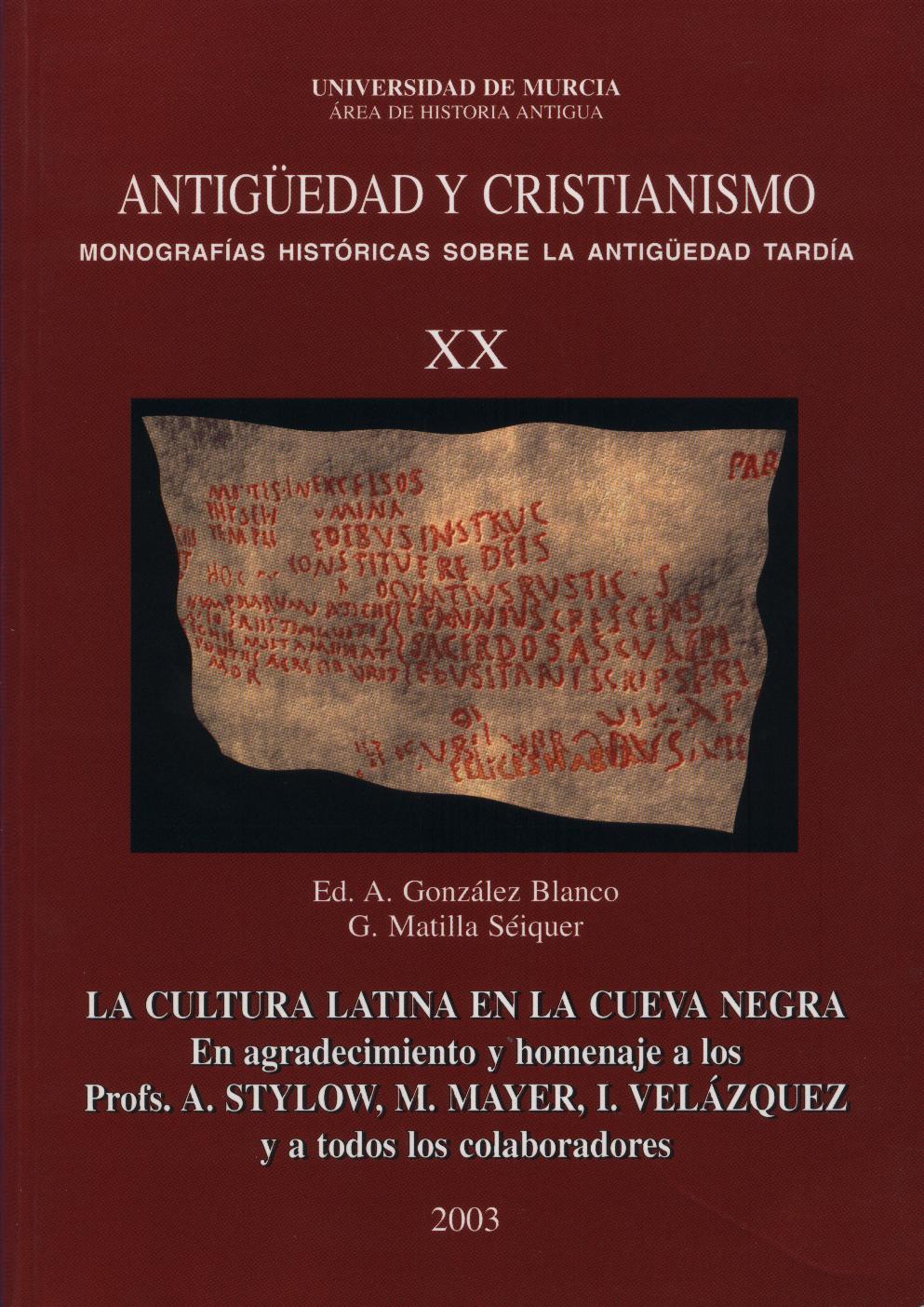Los ‘sodales Heliconi’ de la Cueva Negra de Fortuna (Murcia): una propuesta de interpretación
Abstract
The fundamental object of this study is to determine the reach and significance of the syntagma sodales Heliconi that appears in one of the most well known and studied inscription from the Cueva Negra in Fortuna, and which refers to the visitors to this Cave and to the activity (cult and/or literary) which was carried out within.Although outstanding experts of the Cueva Negra and its tituli picti have tended to coincide in the clear religious connotations of the expression, in my opinion, there is no need to give a religious meaning to an expression that —in in the context in which it appears— simply means «companion of the Muses», and indicates thereby the literary interests shared by those who, in the fi rst and second century D.C. came together in the Cave. To justify this interpretation, I have made a rapid review of the different meanings give to sodales in Latin from the first written testimonies, before giving a more profound look at the literary contests which surrounds the tituli picti and of the terms Helicon and Heliconius in the Latin literature.
Downloads
-
Abstract218
-
PDF (Español (España))105
References
BENVENISTE, E., Le vocabulaire des institutions indo-européennes, vol. I, París 1969.
BLOCH, R., «À propos de l’inscription latine archaïque trouvée à Satricum», Latomus 42, 1983, 362-371.
BREMMER, J., «The suodales of Poplios Valesios», ZPE 47, 1982,133-147.
COLI, U., «Collegia et sodalitates», en Scritti di Diritto Romano, I, Milán, 1973, pp. 1-61.
DAREMBERG, Ch.-SAGLIO, E., Dictionnaire des Antiquités Grecques et Romaines, vol. IV, Graz [1911] 1969.
DUMÉZIL, G., Jupiter Mars Quirinus, vol. IV, París 1941.
ERNOUT, A.-MEILLET, A., Dictionnaire étymologique de la Langue Latine (4ª ed. aumentada y corregida por J. André), París [1932] 1985.
FLOBERT, P., «L’apport des inscriptions archaïques à notre connaissance du latin prélittéraire», Latomus 50, 1991, 521-543.GLARE, P.G.W. (ed.)), Oxford Latin Dictionary, Oxford [1980] 1992.
GONZÁLEZ BLANCO, A. - MAYER, M. - STYLOW, A. U. - GONZÁLEZ FERNÁNDEZ, R., El balneario romano y la Cueva Negra de Fortuna (Murcia). Homenaje al prof. Ph. Rahtz, monogr. Antigüedad y Cristianismo, XIII, 1996 (Murcia).
GONZÁLEZ BLANCO, A., «Los textos de la Cueva Negra y sus perspectivas histórico-religio-sas», en GONZÁLEZ BLANCO, A. et alii, Antig crist, XIII, 1996, op. cit. pp. 477-518.
GRIMAL, P., «La lex Licinia de sodaliciis», en A. Michel-R. Verdière (eds.), Ciceroniana. Hommages à K. Kumaniecki, Leiden, 1975, 107-115.
GUARDUCCI, M., «L’epigrafe arcaica di Satricum a Publio Valerio», RAL 35, 1980, 479-489.
HELLEGOUARC, H. J., Le vocabulaire latin des relations et des partis politiques sous la Republique, París 1971.
LIEBERG, G., «Ovide et les Muses», LEC 48, 1980, 3-22.
LINDERSKI, J., «Ciceros Rede Pro Caelio und die Ambitus- und Vereinsgesetzgebung der ausgehenden Republik», Hermes 89, 1961, 477-518.
MARINER, S., «Comentarios fi lológico y métrico», en GONZÁLEZ BLANCO, A. et alii, op. cit. ([1986]1996) pp. 423-440.
MAYER, M., «La Cueva Negra de Fortuna (Murcia). Tituli picti», en A. González Blanco et alii, Antig crist XIII, 1996, op. cit., pp. 407-422.
RUIZ DE ELVIRA, A., P. Ovidio Nasón. Metamorfosis, vol. II, Madrid 1964.
SIMONE, C. de, «Latino sodalis, un problema di ricostruzione semantica», H. Geckeler et alii(eds.), Logos semantikos, III, Studia Lingüística in honorem Eugenio Coseriu 1921-1981, Berlín-Madrid, 1981, 289-293.
SIMONE, C. de, «L’iscrizione latina arcaica di Satricum: problemi metodologici ed ermeneu-tici», GIF 12 [33], 1983, 25-56.
STIBE, C.M. - COLONNA, G. - SIMONE, C. DE-VERSNEL, H.S. (introd. de M. Pallotino), Lapis Satricanus, La Haya, 1980.
STYLOW, A.U. - MAYER, M., «Los TITVLI de la Cueva Negra. Lectura y comentario literario y paleográfi co», en A. González Blanco et alii, Antig crist XIII, 1996, op. cit. pp. 367-403.
VELÁZQUEZ, I. - ESPIGARES, A., «Traducción al castellano de los textos de la Cueva Negra», en A. González Blanco et alii, Antig crist XIII, 1996, op. cit. pp. 453-475.
VERSNEL, H.S., «Die neue Inschrift von Satricum in historischer Sicht», Gymnasium 89, 1982, 193-235.
WALDE, A. - HOFMANN, J.B. (1954), Lateinisches etymologisches Wörterbuch, Heidelberg.
1. The authors non-exclusively assign the exploitation rights (reproduction, distribution, communication and transformation) to the magazine.
2. The works published in this magazine are subject to the Attribution-ShareAlike 4.0 International license (CC By SA 4.0). Therefore, they can be copied, used, disseminated, transmitted and publicly displayed, provided that:
i) the authorship and the original source of its publication (journal, editorial and URL of the work) are cited, thus allowing its recognition.
ii) it is allowed to remix, transform or create from the material while maintaining the same license as the original.
Note: Articles prior to 2022 incorrectly display the CC by SA license in the abstract page. They are under a CC by NC ND license as embedded in the article pdfs. Articles published in 2022 and after are under the CC by SA license.

3. Self-archiving conditions. Authors are allowed and encouraged to electronically disseminate the pre-print (version before being evaluated) and/or post-print (version evaluated and accepted for publication) versions of their works before publication, as it favors their publication. Earlier circulation and diffusion and with it a possible increase in its citation and reach among the academic community. Color RoMEO: verde.
























